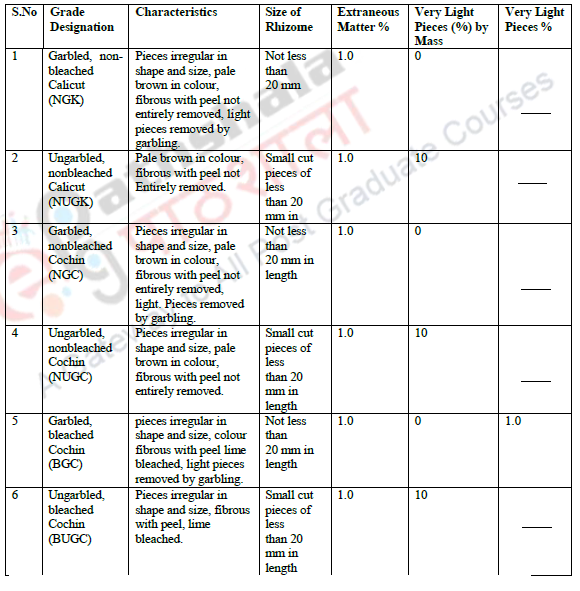23 Ginger: Grading and Curing
23.1. Introduction
The name itself supports this view. The Sanskrit name ‘Singabera’ gave rise to Greek ‘Zingiber’ and later the generic name Zingiber. Ginger (Zingiber officinale Rosc.) is a monocotyledon belonging to the family Zingiberaceae and to the order Zingiberales. In the Zingiberaceae, it belongs to the subfamily Zingiberoideae, which are aromatic with unbranched aerial stems, distichous leaves, open sheaths and hypogeal germination, mainly confined to the old world tropics with the centre of distribution in Indo-Malaysia.
It is a perennial herb, with a large solid, tough, horizontal rhizome, consisting of a series of many pre resistant roundish joints, pale yellow in colour with in covered with pale slippery brown skin, ringed with leaf scars and each marked at the summit by a large circular flat scar, much branched, the new joints coming off below the terminal scars. The root is warming to the body, is slightly antiseptic and promotes internal secretions. It possess stimulant, aromatic and carminative properties, when taken internally & when chewed it acts as a sialagogue. When externally applied it is proficient. The stimulating aromatic and carminative properties render it of much value in atomic dyspepsia especially if accompanied with much flatulence and as an adjunct to purgative medicine to correct gripping. When chewed it is frequently serviceable in relaxed conditions of the tonsils. As rubefacient it will frequently relive head ache and tooth ache. Ginger ndiment is sometimes important in a green state an preserved ginger of the shops is prepared by carefully picking red rhizomes, or the young shoot of the old rhizome, then these are washed and scrapped, they are preserved in jars with syrups. According to Hilary Jacobson, author of “Mother Food,” ginger is a lactogenic herb that helps stimulate letdown of milk. So ginger tea, ginger juice or natural ginger ale may be helpful in good milk flowing.
Ginger, a very useful herb plant, originated from India, China and Java, yet is also native to Africa and the West Indies. Ginger is grown throughout the tropical areas of the world and also commonly found in South East Asia especially in Indo-Malaysia. The main producer of ginger is Jamaica. Ginger is scientifically named as Zingiber officinale Roscoe.
Ginger is marketed in India as a whole in raw condition or in dried form and to same extent it is also used for oil/oleoresin extraction purposes. Ginger can be dehydrated suitably on a small scale in growing centres in rural part of Mizoram, Meghalaya, Nagaland and Arunachal Pradesh. However, Mizoram ginger is low in fibre and has better demand in the market.
Dry ginger is prepared from the underground shoots or rhizomes of Zingiber officinal plant. It isusually prepared by peeling of the outer skin and drying them in sun for about a week. It is also known as unbleached ginger. This is the common practice. But mechanical dehydration increases the production; quality is superior and is more hygienic. This is a versatile product and can be produced in many parts of the country.
23.1.1. Production
Ginger is cultivated in several parts of the world, the most important producing regions being India, China, Nigeria, Sierra Leone, Indonesia, Bangladesh, Australia, Fiji, Jamaica and Nepal. Among them India and China are the dominant suppliers to the world market It is originated in India and grown in almost all the states. In India share of Kerala is maximum in production (19%) from an area share of (18%). It is also grown in Himachal Pradesh, Uttarakhand, Assam, Orissa, Jammu and Kashmir and in north east states like Meghalaya, Sikkim, Mizoram, Manipur, Tripura, Nagaland and Arunachal Pradesh. East Siang, West Siang, Basar, Darang are major ginger producing areas of Arunachal Pradesh.
Ginger is a warm-season crop adapted for growth in tropical and subtropical regions. It can be grown in areas that experience light frosts as long as the rhizomes are not exposed to freezing temperatures. Best growth occurs under moist conditions and temperatures of 25–28°C. Growth efficiency declines with temperatures above 30°C and below 24°C.As for as soil is concerned, it should have ideal pH of 5.5–6.5. Ginger requires a deep (25–40 cm), rock-free, sandy loam soil, high in organic matter with adequate drainage that allows for proper hilling of the crop.
Ginger is a cash crop which is propagated vegetatively. Produce stored for this purpose varies from region to region depending upon the seed rate, variety, soil, cultural practices and the cropping plan of the farmers for the next year. Some farmers are retaining larger quantities for future sales. On an average, about 15% of the produce is kept for seed in Ernakulam district while in Wynad, farmers kept about 18% for this purpose. Generally it can’t be stored for long due to its perishable character.
23.1.2. Nutritional value
One hundred grams of edible ginger contain approximately 9 g protein, 6 g fibre, 116 g calcium, 71 g carbohydrate, and 147 IU of Vitamin A.
23.1.3. Varieties
Most varieties of ginger are Nadia, Maran, Rio-de-janeiro, China, Wynad Kuruppampadi, Ernad, Suprabha, Suruchi, Surabi, Varad and Himgiri.Yield and oil characteristic and content vary with cultivar and environmental factors. There are many local varieties grown over the world. More than 400 accessions of ginger are maintained at the Indian Institute for Spice Research in Calicut, Kerala, India, and about 45 are at the research Institute for Spices and Medicinal Crops in Bogor, Indonesia.
23.1.4. What is it made up of?
The important active components of the ginger root are thought to be volatile oils and pungent phenol compounds (such as gingerols and shogaols).
23.1.5. Available Forms
Ginger products are made from fresh or dried ginger root, or from steam distillation of the oil in the root. The herb is available in extracts, tinctures, capsules, and oils. Fresh ginger root can also be purchased and prepared as a tea. Ginger is also a common cooking spice and can be found in a variety of foods and drinks, including ginger bread, ginger snaps, ginger sticks, and ginger ale.
23.1.6. Usage of Ginger:
Ginger has been used for a few purposes since very early times. It is used as a medicine since many years ago. It is also widely used as a cooking herb, condiment, spice and home remedy for a long time ago.
In medicinal uses, the ginger root is an effective treatment for nausea caused by motion sickness or other sickness. Ginger extract also has long been used in traditional medical practices to decrease inflammation. Today, many herbalists use ginger to help treat health problems associated with inflammation, such as arthritis, bronchitis, and ulcerative colitis. To shorten the story, ginger oil is used in the treatment of fractures, rheumatism, arthritis, bruising, carbuncles, nausea, hangovers, travel and sea sickness, colds and flu, catarrh, congestion, coughs, sinusitis, sores on the skin, sore throat, diarrhoea, colic, cramps, chills and fever. Besides that, ginger oil is used for cooking, as flavouring for cookies, biscuits and cake, and it is the main flavour in ginger ale, a sweet, carbonated, non-alcoholic beverage.
Ginger contains chemicals that may reduce nausea and inflammation. Researchers believe the chemicals work primarily in the stomach and intestines, but they may also work in the brain and nervous system to control nausea. In foods and beverages, ginger is used as a flavouring agent. In manufacturing, ginger is used as for fragrance in soaps and cosmetics. One of the chemicals in ginger is also used as an ingredient in laxative, anti-gas, and antacid medications.
Ginger is used as a spice.
- It is used for the preparation of Ginger oil and oleoresin.
- It is used in the preparation of soft drinks, alcoholic beverages.
- Preserved Ginger is used for the manufacture of processed food.
- Green Ginger is used in the culinary preparations.
23.1.7. World Scenario
The total production of ginger in the world is 1683.00 thousand tons with the total acreage of 310.43 thousand ha. China, India, Nepal and Thailand are the major producers of ginger in the world, having production of 396.60 thousand tons, 385.33 thousand tons, 210.79 thousand tons and 172.68 thousand tons respectively. India and Indonesia have the largest area under cultivation.
Area, Production and Productivity of Ginger in the World
23.1.1. Indian Scenario
There is only marginal increase in acreage from 108.64 thousand ha in 2008-09 to 149.10 thousand ha in 2010-11.The production, however has increased from 380.10 thousand tons in 2008-09 to 702.00 thousand tons in 2010-11.The details are given in table.
Area, Production and Productivity of Ginger in India
23.2. Grading of Ginger:
Ginger should be harvested after the leaves have died. After harvest, fibrous root attached to the rhizomes should be removed moreover; soil attached to them is also removed by washing. Each rhizome should be washed in water. A high pressure hose, coconut fibre or a soft brush and copious water can be used to give a fresh appearance. Care required during this operation to prevent breakage. Rhizomes should be soaked in water overnight and then cleaned. The skin can be removed by bamboo splits or wooden splice. After scraping the rhizomes, should be sun dried for a week with frequent turnings and skin should be removed by rubbing with hands. This is called as unbleached ginger. However, if these are immersed in 2% lime solution for 6hrs followed by sun drying, then can be termed as bleached ginger. Proper care required during this operation, which will assist in minimizing microbial damage and may improve presentation. Ginger can be graded as peeled, unpeeled, rough scraped, bleached, splits, slices and ratoons based on process of drying.
Grading should be carried out in the field to remove rhizomes that do not immediately attain the export specifications. Grading is also required prior to packing to remove broken or damaged rhizomes which occurred during field transport and handling. These graded different forms of rhizomes should be packed in jute sacks, wooden boxes or lined corrugated cardboard boxes depending upon distance for transportation and type of market. Dry slices or powder should be packed in multi-wall laminated bags or polyethylene film pouches.
Grade Designations of Ginger, Whole and Their Requirements (clause 4.2,BIS)
23.3. Export Grading and Packing
Ginger is loose packed in layers. Size grading is not usually carried out within cartons, assuming that all rhizomes meet required size specifications. In some cases, size grading is carried out where different grades of ginger are being exported. For sea-shipment an additional 5% weight is required to account for weight loss during transport. Net weight requirements vary from 12 to 13.6 kg (27 to 30 lbs) depending on the market and importer requirements. Cartons must not be over-filled during packing.
23.4. Curing of ginger
Ginger intended for storage should be cured by air drying the bulbs at average temperature, 22°C to 26°C, (71.5°F to 79°F) and 70% to 75% RH for several days to allow the skin to thicken and the cut surfaces to heal. Curing will help reduce postharvest weight loss and decay. Following this brief curing treatment, the ginger should be put in well ventilated containers for long-term storage.
23.4.1. Purpose of Curing
1) To improve quality.
2) To improve keeping quality or shelf life.
3) To avoid loss due to market glut.
4) Facilitate use in off-season.
5) Use for industrial purpose.
6) Retention of flavour.
23.4.2. Methods of Curing
23.4.2.1. Surat Method
a. Green ginger is soaked in water to facilitate removal of skin.
b. Skin is scrapped-off with pieces of sharpened bamboo or bits of sea shells or choir with great care and skill to avoid loss of essential oil.
c. Scrapped produce is washed and dried in sun for 3-4 days and hand rubbed. It is again soaked in water for 2 h, dried and then rubbed to remove all the remaining bits of skin.
d. Sun drying also helps to bleach the produce.
e. This type of curing is rather slow but preserves the flavour and hence is beneficial.
23.4.2.2. Malabar Method
a. Mainly followed in Kerala.
b. Rhizomes are soaked in 2% clear lime water [Ca (OH)2] for 6 hrs.
c. They are then transferred to sulphuring chamber for12 hrs. ;
d. The complete procedure is repeated 3 times to bleach the ginger and give it white colour before drying.
23.4.2.3. Caustic Soda Method
a. Fully matured rhizomes are taken, washed and peeled.
b. They are dipped in 20 %, 25% and 50% caustic coda solution for 5 minutes, 1 minute and ½minute respectively.
c. They are then transferred to 4% citric acid solution for 2 hours.
d. They are then thoroughly washed with water and dried in sun till moisture content is 15- 20%.
e. Finally they are polished and packed.
Summary
Ginger is one in all the foremost extensively used spices due to its big selection of application. It’s used extensively and within the preserved or dried type. The potential of ginger within the preparation, non-culinary and medicative fields is predicated on the chemistry of oil and non- volatile pungent principles. The oil yield is regarding 2–3% and therefore the oil consists of 64% sesquiterpene hydrocarbons, 6 June 1944 carbonyl compounds, five-hitter alcohols, a pair of monoterpene hydrocarbons and a hundred and twenty fifth esters. The most compounds are zingiberene (29.5%) and sesquiphellandrene (18.4%). The pungent compounds are gingebrace gingerols, shogaols, paradols and zingerone, which turn out a ‘hot’ sensation within the mouth. The composition of those constituents varies, supported maturity, genotype and agro climatic conditions. Ginger hasestablished medicine, inhibitor and anti-ulcer principles
| you can view video on Ginger: Grading & Curing |






